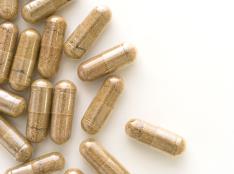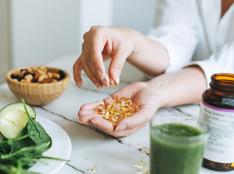Allergies to Soy, Eggs, Nuts: Toasted Rainbow Quinoa with Roasted Tomatoes
1 of 9
For athletes with egg, nut and soy allergies who want a protein source that doesn't involve chicken, fish, meat or pork, quinoa is an excellent choice. It contains all nine amino acids (histidine, isoleucine, leucine, lysine, methionine, phenylalanine, threonine, tryptophan and valine), making it a complete protein, according to the Whole Grains Council. One cup of cooked quinoa has 8 grams of protein and 39 grams of carbohydrate. Because quinoa is a relatively blank canvas in terms of taste, it can be prepared with sweet or savory ingredients. This recipe reflects the latter. And the sodium in the vegetable broth and Pecorino Romano cheese provides electrolytes.
Get more
Recipes and Nutrition AdviceGluten-Intolerant: Gluten-Free Penne with Shrimp and Pesto
2 of 9
It used to be much tougher for gluten-free runners and cyclists to find easy carbs, such as bread and pasta, to fuel their workouts. Today, there are dozens of gluten-free foods available to gluten-intolerant or gluten-sensitive athletes. And many are fortified with fiber, iron and B vitamins, making them just as nutrient-rich as the wheat-filled versions of the same products. If you're looking for some carb-given energy, try this gluten-free penne with shrimp and pesto recipe. In addition to carbs, it's also rich with protein and vitamins C and K.
Get more
Recipes and Nutrition AdviceIntestinal Diseases: Savory Pumpkin, Cheddar and Sage Scones
3 of 9
Many athletes with Crohn's disease, ulcerative colitis, IBD or chronic diarrhea have been helped by the specific carbohydrate diet (SCD). Biochemist and cell biologist Elaine Gottschall, who believed these conditions are the result of an overgrowth and imbalance of intestinal microbial flora, created the diet. Gottschall's research showed that carbohydrates that aren't fully absorbed stay in the gut, feed microbes that cause inflammation and irritate the gut. The SCD specifies consuming carbohydrates that require minimal digestion, don't cause microbial overgrowth and are therefore well absorbed. People who follow this diet must limit grains, corn, potatoes and refined sugar—all of which many endurance athletes rely on for pre-race energy. SCD athletes train their bodies to burn proteins and simple carbohydrates found in fruits, vegetables and honey. These savory pumpkin scones combine a base of protein-rich almond flour with pumpkin puree, honey, among other SCD-approved ingredients.
Get more
Recipes and Nutrition AdviceLactose-Intolerant: Chicken with Mushrooms, Red Wine and Roasted Garlic
4 of 9
Lactose-intolerant athletes who can't eat dairy and lactose-sensitive athletes who must severely limit dairy have to look for alternative sources of protein, calcium and vitamin D. Chicken, fish, nuts, beans and eggs are packed with healthy protein. Non-dairy milks, such as almond, soy or coconut milks, and orange juice are often fortified with calcium. Dark leafy greens such as spinach, kale, turnips and collard greens, are also calcium-rich. And mushrooms—especially those exposed to UV light—contain vitamin D, according to the USDA.
This chicken and mushroom recipe delivers plenty of protein and vitamin D as well as electrolytes from the stock and salt. Serve the dish with brown rice and a side of spinach, and you'll also get a healthy dose of carbohydrates and non-dairy calcium.
Get more
Recipes and Nutrition AdvicePescetarians: Asian Salmon Bowl with Lime Drizzle
5 of 9
Pescetarians eat fish, but not other animal proteins such as chicken, meat or pork. They get a wide range of nutrients from all the plants, grains and omega-3 rich fish, however they can be iron-deficient. If you're a pescetarian, pay special attention to the dark, leafy greens and fortified grains such as oatmeal, barley and rice, so you get enough iron. This salmon dish includes both rice and baby spinach, which are both high in iron.
Get more
Recipes and Nutrition AdviceType 2 Diabetes: Red Lentil and Black Bean Stew
6 of 9
Athletes with Type 2 diabetes, the most common form of diabetes in which one's body doesn't make or use insulin well, have to be cognoscente to avoid sugary and refined foods that raise blood-sugar levels quickly. High-quality carbohydrates, lean proteins and soluble fiber such as black beans and lentils, help stabilize the body's blood-sugar levels, according to nutrition expert Joy Bauer. If you have Type 2 diabetes, try this red lentil and black bean stew. In addition to being rich with high-quality carbs, proteins and fiber, it also contains chili powder, which helps the liver flush excess insulin.
Get more
Recipes and Nutrition AdviceVegan: Butternut Squash Soup with Fresh Basil
7 of 9
Vegans have a tendency to be deficient in calcium, iron, zinc, long-chain fatty acids EPA and DHA, and vitamins A, D and B12, according to Chris Kresser, practitioner of functional and integrative medicine. Vitamin B12 is important for endurance athletes because it affects red blood cell production. It's naturally found only in meat, however many companies are now fortifying cereals and non-dairy milks with it. This soup recipe calls for almond or coconut milk. Try Silk, which fortifies its milks with B12 as well as vitamins A and D, iron, zinc and calcium. And the butternut squash also contains vitamin A.
Get more
Recipes and Nutrition AdviceVegetarian: Savory Shiitake Bowl with Kale and Brown Rice
8 of 9
The five most common vegetarian nutrient deficiencies are omega-3, zinc, B12, iron and calcium, according to FitDay. In comparison to sedentary individuals, athletes require more calcium and iron. Endurance athletes can experience low levels of iron because the mineral is lost through sweat. This bowl calls for tofu and kale, both of which provide iron and calcium. There's also iron in brown rice. And the sesame seeds contain omega-3s.
Get more
Recipes and Nutrition Advice9 of 9
Next Gallery
Active Cookbook: Best Slimmed-Down Carb- and Protein-Rich Recipes for Athletes







Discuss This Article